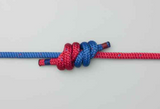Five Knots to Know

Thinking about “tying the knot” with your loved one? For centuries, marriage ceremonies have featured a knot tying ritual as a symbol of unity and strength. In the field, knots can make a job easier or even save your life! Below are 5 knots you need to know if you are ever in a bind or just want to show off to that special someone.

Fisherman’s Knot
Also known as the true lover’s knot, this is one of the strongest knots. It is used to join the ends of two ropes and is favored by fishermen and rescuers alike because of its ease of tying. Even with cold, wet hands, the knot can be formed efficiently and result in smaller knots. Like relationships, this knot grows stronger under pressure. The fact that it grows stronger with tension, is what makes it one of strongest/ secure knots around. One important note is that the fisherman’s knot can be almost impossible to untie while under load.
See how to tie this knot HERE.

Figure Eight Bend
Resembling the infinity sign, this stopper knot is used at the end of a rope to prevent it from slipping through an opening. It’s easy to teach, tie, check, and untie, making it popular among a wide range of users; from rescue workers, to rock climbers, to arborists. Also called the Flemish bend, this knot doesn't require a backup: as Fox Mountain Guides explains, “it takes two gestures to fail. If you undo the last ‘pass through’ of the follow through, you would still have a complete knot that will not come undone... If you undo another pass through, then the knot would come undone under weight.”
See how to tie this knot HERE.

Half Hitch
While it is not recommended for use on its own, the half hitch knot is a fundamental component of several other knots. A simple overhand knot, it’s fast to execute and untie. It’s fine in a pinch, but should not be relied on for safety. A half hitch can slip or jam but can be strengthened by doubling it.
See how to tie this knot HERE.

Prusik Hitch
A prusik knot or prusik hitch (often misspelled as “prussik”) is a knot that can be very handy for climbers. When not under pressure, the knot slides freely along another rope, but as soon as it’s loaded, grips tightly, allowing the user to ascend the other rope. It was developed in 1931 by Dr. Karl Prusik, a former president of the Austrian Mountaineering Club, and is now widely used in canyoneering, mountaineering, caving, rope rescue, ziplining, and by arborists.
See how to tie this knot HERE.

Bowline Knot
The bowline knot is often referred to as the “king of knots” because of its strength and versatility. It’s usefulness in life-saving situations cannot be understated. The bowline can be tied with one hand and doesn’t slip. During a rescue, the person in need can hold the rope tightly in one hand and secure a loop around themselves with the other. A good bowline is very secure, but beware, like the Fisherman’s knot, it becomes impossible to untie while under pressure.
See how to tie this knot HERE.
Photo Credits:
Photo by Susanne Jutzeler from Pexels
Photo by Animated Knots by Grog | Learn how to tie knots with step-by-step animation


